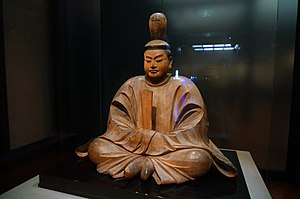Hachiman
[4] The first mention of this kami is found in the Shoku Nihongi as it contains the information that offerings were sent 794 CE to Hachiman shrines on the occasion of conflict with the kingdom Silla in Korea.
[5] In Shinto religion, he is mortally Emperor Ōjin (応神天皇, Ōjin Tennō) by birth who reigned in the 3rd–4th century and the son of Empress Jingū (神功皇后, Jingū-kōgō), later became deified and identified by legend as "Yahata-no-kami" meaning "Kami of Eight Banners", referring to the eight heavenly banners that signaled the birth of the divine and deified emperor, and is also called Hondawake (誉田別命).
His messenger is the dove, symbolizes both the bow and arrow found in samurai banners associated to him where he is called "Yumiya Hachiman [ja]".
Since ancient times Hachiman has been worshiped by farmers as the god of agriculture and by fishermen, who hoped that he would fill their nets with many fish.
His other roles include determining a samurai's fate—i.e., whether they are a success or failure in battle; controlling and protecting the martial arts; and proclaiming the victory of an army.
Amongst the Hachiman Mikami, there are many shrines that enshrines other figures apart from the trio, like Emperor Chūai (仲哀天皇, Chūai-tennō) instead of Empress Jingū, the legendary hero and Shinto deity Takenouchi no Sukune or Takeshiuchi no Sukune (武内宿禰) and the female deity Tamayori-hime (玉依毘売命 or 玉依姫尊), where there is a dedicated prayer for safe childbirth in the Shinto shrine of Umi Hachimangū (宇美八幡宮) in Umi, Fukuoka prefecture.
"pledge divination") between the goddess Amaterasu and the god Susanoo - that is Tagitsu-hime (多岐津姫命), Ichikishima-hime (市杵嶋姫命) and Tagairi-hime (多紀理姫命) - is said where they descended from the heavens as the "Three Pillars of Usanoshima (宇佐嶋) of the ancient province of Tsukushi (筑紫)", located in a temple complex on Mt.
Himegami (比売神) is thought to be the consort or aunt of Hachiman, whereas Tamayori-hime (玉依毘売命 or 玉依姫尊) possibly and perhaps as the mother viewed by opinion aforementioned.
Since the description of Hachiman as the Emperor Ōjin appeared in the "Digest Record of Todai-ji Temple (東大寺要録 Tōdai-ji Yoroku)" and "Records of the Age of the Gods from the Sumiyoshi Grand Shrine (住吉大社神代記 Sumiyoshi-Taisha Jindaiki), the practice of merging Emperor Ōjin into Hachiman is estimated to have begun in the Nara Period or the Heian Period.





